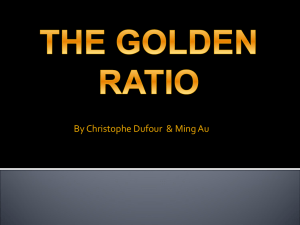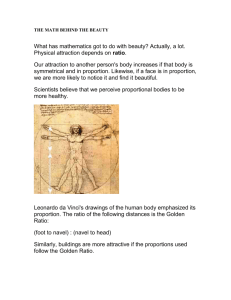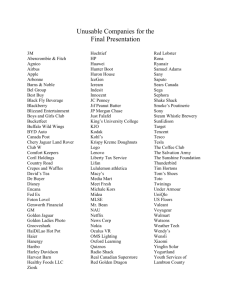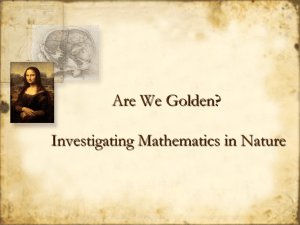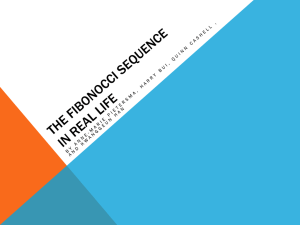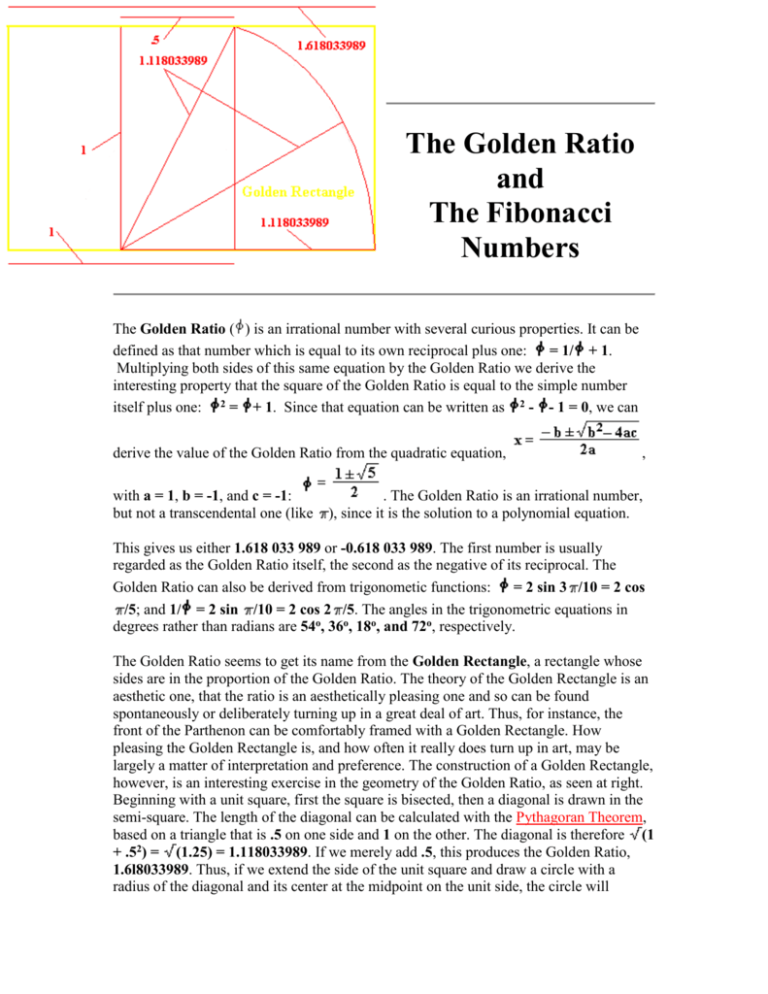
The Golden Ratio
and
The Fibonacci
Numbers
The Golden Ratio ( ) is an irrational number with several curious properties. It can be
defined as that number which is equal to its own reciprocal plus one:
= 1/ + 1.
Multiplying both sides of this same equation by the Golden Ratio we derive the
interesting property that the square of the Golden Ratio is equal to the simple number
itself plus one: 2 = + 1. Since that equation can be written as 2 - - 1 = 0, we can
derive the value of the Golden Ratio from the quadratic equation,
with a = 1, b = -1, and c = -1:
but not a transcendental one (like
,
. The Golden Ratio is an irrational number,
), since it is the solution to a polynomial equation.
This gives us either 1.618 033 989 or -0.618 033 989. The first number is usually
regarded as the Golden Ratio itself, the second as the negative of its reciprocal. The
Golden Ratio can also be derived from trigonometic functions:
= 2 sin 3 /10 = 2 cos
/5; and 1/ = 2 sin /10 = 2 cos 2 /5. The angles in the trigonometric equations in
degrees rather than radians are 54o, 36o, 18o, and 72o, respectively.
The Golden Ratio seems to get its name from the Golden Rectangle, a rectangle whose
sides are in the proportion of the Golden Ratio. The theory of the Golden Rectangle is an
aesthetic one, that the ratio is an aesthetically pleasing one and so can be found
spontaneously or deliberately turning up in a great deal of art. Thus, for instance, the
front of the Parthenon can be comfortably framed with a Golden Rectangle. How
pleasing the Golden Rectangle is, and how often it really does turn up in art, may be
largely a matter of interpretation and preference. The construction of a Golden Rectangle,
however, is an interesting exercise in the geometry of the Golden Ratio, as seen at right.
Beginning with a unit square, first the square is bisected, then a diagonal is drawn in the
semi-square. The length of the diagonal can be calculated with the Pythagoran Theorem,
based on a triangle that is .5 on one side and 1 on the other. The diagonal is therefore (1
+ .52) = (1.25) = 1.118033989. If we merely add .5, this produces the Golden Ratio,
1.6l8033989. Thus, if we extend the side of the unit square and draw a circle with a
radius of the diagonal and its center at the midpoint on the unit side, the circle will
intersect the side at a point that will be 1.6l8033989 units from the
corner of the square. In effect, this gives us an equation for the
Golden Ratio:
= .5 + 1.25. We can easily turn this into the
previous equation, however, just by muliplying the numbers so as to
get integers:
= 1 / 2 + 2 1.25 / 2 = (1 + 2 1.25) / 2 = (1 + (4 *
1.25)) / 2 = (1 + 5) / 2.
Whether or not the Golden Ratio or the Golden Rectangle are of
aesthetic significance, the ratio does turn out to have considerable
significance in problems of natural symmetry. For instance, a surface can be completely
and symmetrically tiled with triangles, squares, and hexagons, but not with pentagons.
Periodic five-fold symmetry does not occur in nature. However, in the early 70's Roger
Penrose discovered that a surface could be completely tiled in an asymetrical and nonperiodic way with just two shapes, called "kites" and "darts" -- "Penrose tiles" -- as seen
at right. Within this tiling, however, there can be small areas of five-fold symmetry.
Multiple decagons, some of which from a distance can look like pentagons, can occur.
Now, it just so happens, that, given a large enough area, the ratio of kites to darts is just
the Golden Ratio. Why would this happen? Well, a complete circular angle (360o)
divided by five is 72o, which occurred above as one of the angles whose trigonometric
function is the Golden Ratio. More conspicuously, the very irrationality of the Golden
Ratio is an artifact of the square root of five:
. If the Golden Ratio turns up
in examples of five-fold symmetry, it may well be because the number itself is
fundamentally related to the number five.
n
n
Another connection of the Golden
Ratio to partial symmetries in
nature is through the Fibonacci
Numbers
( fn ). This is a number series where
each member is simply the sum of
the previous two numbers. Thus, if
we begin with 0 and 1, these add
up to 1, but then 1 and 1 add up to
2, 2 and 1 add up to 3, 3 and 2 add
up to 5, 5 and 3 add up to 8, etc.
The series can be extended below
zero when we ask what number
added to 0 will produce 1, which is
then 1. The number added to 1 that
will produce 0 is -1. It happens,
then, that below zero, we find the
same Fibonacci Numbers, but they
alternate as positive and negative.
The Fibonacci Numbers from the
minus eleventh to the twentieth
(with zero as the "zeroth") are
listed in the table at right.
Now, the Fibonacci Numbers turn
up in nature. The spirals
discernible in the head of a daisy
consist of individual "florets" that
count up as Fibonacci Numbers.
This is significant here because the
ratio between any two successive
Fibonacci Numbers approaches a
limit as the numbers get larger, and
that limit is the Golden Ratio.
Thus, 6765/4181 (the 20th and
19th Fibonaccis) is 1.618033963,
which only differts from the
Golden Ratio by 0.000000025.
The table at right illustrates an
interesting way in which the
Fibonacci Numbers occur naturally
in relation to the Golden Ratio.
This is based on the property of the
Golden Ratio already noted above,
that 2 = + 1. Similarly, any
fn
= fn + f n-1
n-1
=
=
=
n-2
+
n+1 n+2 -
n-1
n+1
-11 89
-10 -55
-10
-9
34
-9
= 34 - 55 =
-10
-8
-21
-8
= 34 - 21 =
-9
+
-10
-7
13
-7
= 13 - 21 =
-8
+
-9
-6
-8
-6
= 13 - 8 =
-5
5
-5
=5 -8=
-6
+
-7
=
-3
-
-4
-4
-3
-4
=5-3 =
-5
+
-6
=
-2
-
-3
-3
2
-3
=2 -3=
-4
+
-5
=
-1
-
-2
-2
-1
-2
=2- =
-3
+
-4
=1-
-1
1
-1
= -1=
-2
+
-3
= -1
0
0
1
1
= +0=1+
2
1
2
= +1= +1
3
2
3
=2 +1=
2
+ =
4
3
4
=3 +2=
3
+
2
5
5
5
=5 +3=
4
+
3
6
8
6
=8 +5=
5
+
4
7
13
7
= 13 + 8 =
8
21
8
= 21 + 13 =
7
+
6
9
34
9
= 34 + 21 =
8
+
7
10
55
10
= 55 + 34 =
9
11
89
11
= 89 + 55 =
10
12
144
12
= 144 + 89 =
13
233
13
= 233 + 144
1=0+1=
14
-11
= 89 - 55 =
-1
-7
-11
+
-8
+
-2
+
-12
+
-8
=
-7
=
-6
=
-5
=
-4
=
-
-1
-1
= -
-1
6
5
6
=
4
-
5
+
8
+
+
11
+
9
10
5
-9
-
-8
-
-7
-
-6
-
-5
equal to 13
power of the Golden Ratio can be broken down into the sum of smaller
powers, such as 5 = 4 + 3. Because of this, any power of the
Golden Ratio can be ultimately reduced to the sum of an integer and an
interger multiple of the Golden Ratio. An example of going through
this whole process for a large power is given in a footnote. Curiously,
all of those integers turn out to be Fibonacci Numbers. Thus, 7 is
+ 8. This can be generalized, that every power n of is equal to fn + f n-1.
While we see that the Fibonacci series emerges naturally in the evaluation of the powers
of the Golden Ratio, this does not necessarily make it clear why the ratio of the members
of the Fibonacci series should approach the Golden Ratio as a limit. As it happens, the
connection can be illustrated through the technique of Continued Fractions, which is a
device for reducing non-repeating decimals to fractions, i.e. to ratios of integers. The
technique for reducing repeating decimals to fractions has been discussed elsewhere.
With non-repeating decimals, the integer part of the number is successively removed, and
the reciprocal is taken of the remaining decimal, producing a new integer, which is then
removed, and the process repeated. This can be continued until the desired accuracy is
attained or the capacity of the calculator is exceeded -- since I would assume that most
people today would be using a calculator to get the reciprocals (it is not a very convenient
procedure otherwise). Once enough integers are obtained, the corresponding fraction with
all the embedded fractions can then be solved for a simple integer fraction.
For instance, at right is a continued fraction for the ratio between the the length of the
lunar (synodic) month (29.530588 days), and the length of the solar (tropical) year
(365.24219878 days). This tells us the number of lunar months per solar year; and, in
integer form, the fractional part would tell us how many extra lunar months (more than
12 per year) would need to be added in a certain period of solar years to approximate the
true ratio. The true ratio is 12.368267058. Removing the 12 and then successively taking
the reciprocal and removing the integer part again gives us the integers, after 12, 2, 1, 2,
1, 1, and 17 (at least). Successive approximations can be made by stopping at each new
integer. Thus, with only 2, we would have the approximation 12+1/2. Stopping with the
next 1, 1 gets added to the 2, and the next approximation is 12+1/3. Adding in the next
number, a 2, produces a fraction of 3/8, which is historically very important because a
popular ancient device for approximating the lunar calendar to a solar year was to add 3
extra months every 8 years. More important, however, was the fraction two steps
further. Adding 7 lunar months every 19 years was a device adopted for the Babylonian
Calendar. The rule was inherited and used even today by the Jewish Calendar and for the
Christian reckoning of Easter. The next fraction in the series, 123/334, is too large to
have been practical for calendrical purposes. (The continued fraction for is given in a
footnote.)
The Golden Ratio has the unique properties that its reciprocal always
produces the same decimal and the reciprocal of the decimal will
always produce the integer 1. This means that the continued fraction
can be constructed without bothering with a calculator! The
continued fraction uniquely only has 1's in it. This also means that
the successive fractions can be generated without consulting the
diagram. For each fraction, we add 1
and then flip it over (make the
reciprocal) for each new fraction.
Thus, the first number is 1,
producing the fraction 1/1. That is its
own reciprocal. To this is added 1
(1/1), resulting in the fraction 2/1.
The reciprocal of that is 1/2, our
second fraction. To that is added 1
again (now 2/2), resulting in the
fraction 3/2. The reciprocal of that is
2/3, our third fraction. To that is
added 1 again (now 3/3), resulting in
the fraction 5/3. The reciprocal of
that is 3/5, our fourth fraction. As
this continues, we might notice that
the procedure generates fractions that all consist of successive Fibonacci Numbers! This
is why ratios of Fibonacci numbers approximate the Golden Ratio, they are all solutions
to the unique continued fraction for the Golden Ratio!
I have now received from Devin Chalmers in Juneau, Alaska, a derivation of directly
from a definition of the Fibonacci Series (equation 1). Equation 2 moves the definition
over one in the series; then we divide both sides by a(n) in equation 3, which we
manipulate with a bit of algebra. The limit of both ratios in equation 4 should be the same
number, so we replace them with the variable in equation 5. This is equivalent to
equation 6, which, as we've seen above, can be plugged into the quadratic equation to get
equation 7.
Thus, while the Golden Ratio may not be as important as other mathematical constants,
it does have its claim to fame and does have its own unique properties. And, with one
further reflection, we can put it into very serious company indeed. Thus, if we define the
Golden Ratio as that number which, when one is substracted, is equal to its own
reciprocal ( - 1 = 1/ ), we might ask in turn what number, when multiplied by minus
one, is equal to its own reciprocal ( x * -1 = 1 / x ). This turns out to be the imaginary
number, i = -1: -i = l / i. This is a much more significant and mysterious number than
the Golden Ratio -- not bad as a kind of cousin.
Philosophy of Science
Home Page
Copyright (c) 1999, 2003 Kelley L. Ross, Ph.D. All Rights Reserved
The Golden Ratio and The Fibonacci Numbers, Note 1
Example; reducing a power of the Golden Ratio to a linear quantity
+ 6 = ( 6 + 5) + 6 = (( 5 + 4) + 5) + ( 5 + 4) = 3 5 + 2 4 = 3( 4 + 3) +
2( 3 + 2) = (3 4 + 3 3) + (2 3 + 2 2) = 3 4 + 5 3 + 2 2 = 3( 3 + 2) + 5 3 + 2 2 =
(3 3 + 3 2) + 5 3 + 2 2 = 8 3 + 5 2 = 8( 2 + ) + 5( + 1) = (8 2 + 8 ) + (5 + 5) =
8 2 + 13 + 5 = 8( + 1) + 13 + 5 = (8 + 8) + 13 + 5 = 21 + 13
8
=
7
Return to text
The Golden Ratio and The Fibonacci Numbers, Note 2;
The Continued Fraction for Pi
The continued fraction for is of some interest because Greek attempts to derive a value
for always gave it in the form of a fraction -- the ancients did not have decimal
notation. The best they could do, according to Isaac Asimov ("A Piece of Pi," 1964), was
22/7, which is only the smallest fraction in the series (afer 3/1, of course). Archimedes
found that was smaller than 22/7 and larger than 223/71, but this still wasn't good
enough to find the next fraction in the series. It wasn't until the 16th Century that the
value 355/113 was discovered. As you can see, this is actually the best that can be done
with a relatively simple fraction, and modern mathematicians had new notation and
methods for tackling anyway, without continuing to state it as a fraction at all. The next
couple of fractions in the series, however, do produce extraordinarily precise values.
104,348/33,215 differs from by only 1/3,030,303,030; and 103,993/33,102 differs by
only 1/1,724,137,931. By comparison, 355/113 differs from by 1/3,748,688; 333/106
by 1/12,016; and 22/7 by 1/791. Any desire for integer values of , across a large range
of accuracy, is thus easily met.
Return to text on the Golden Ratio
Text on the Continued Fraction for the Synodic Month
Philosophy of Science
Home Page
Copyright (c) 1999 Kelley L. Ross, Ph.D. All Rights Reserved


